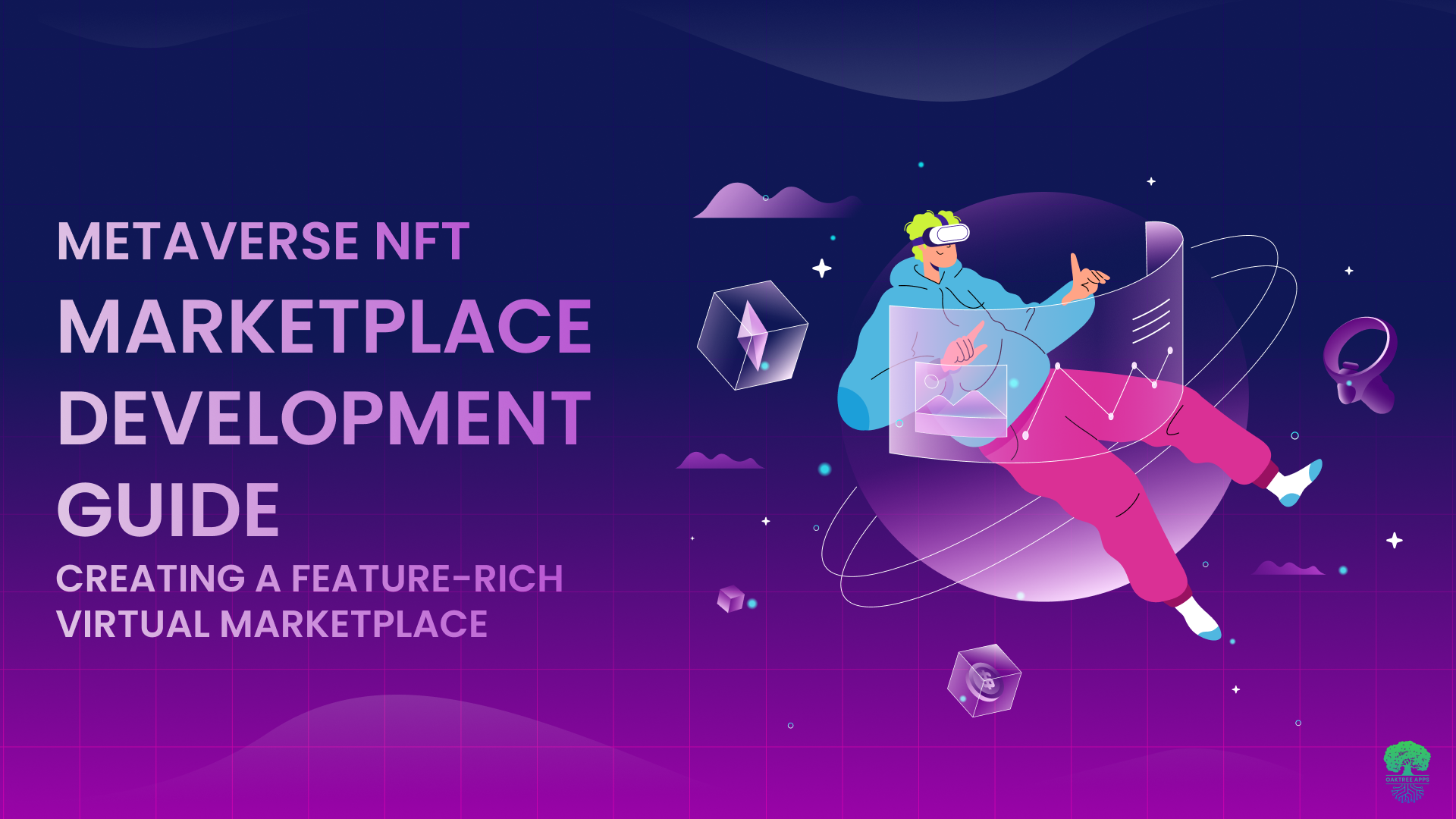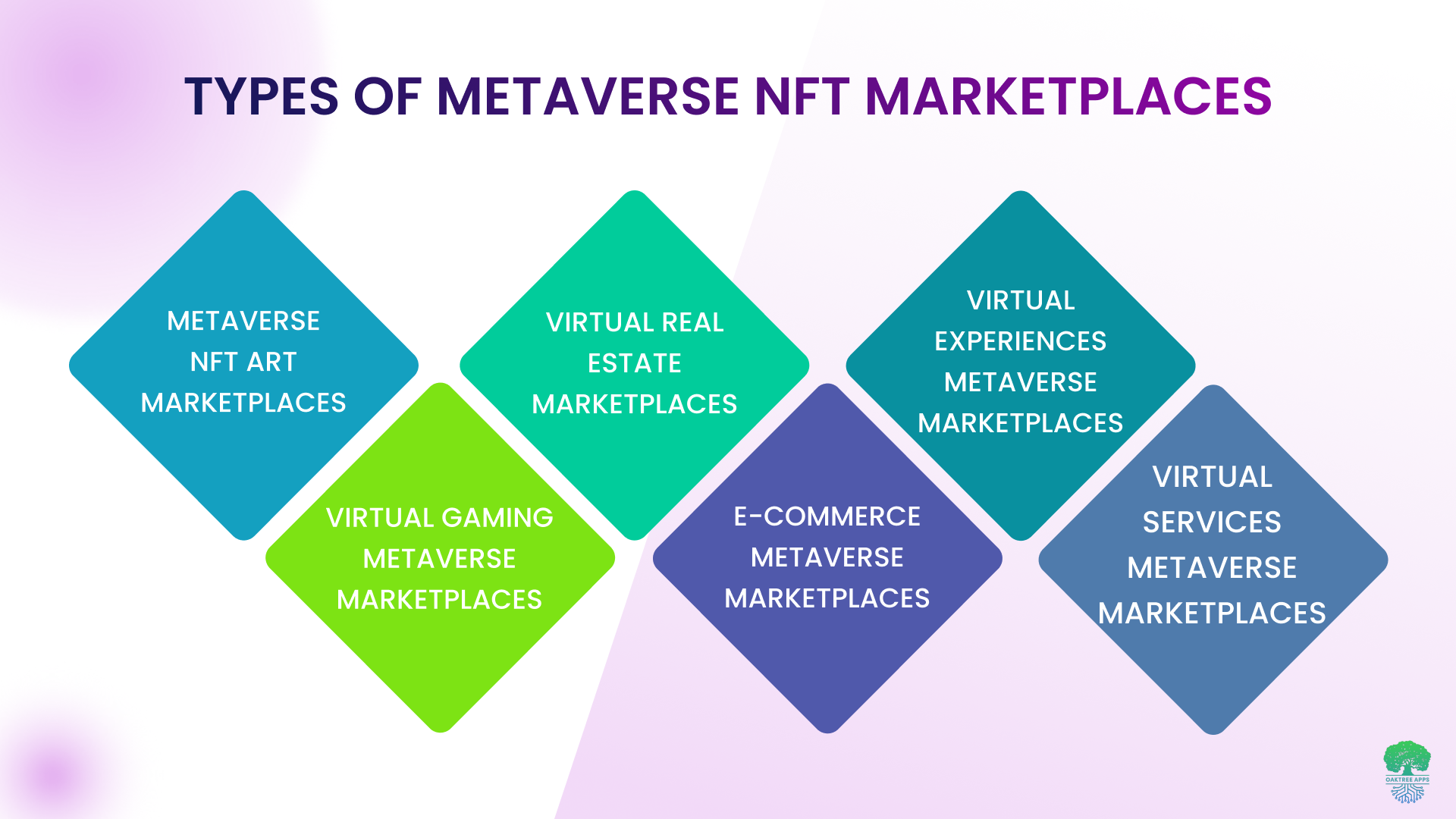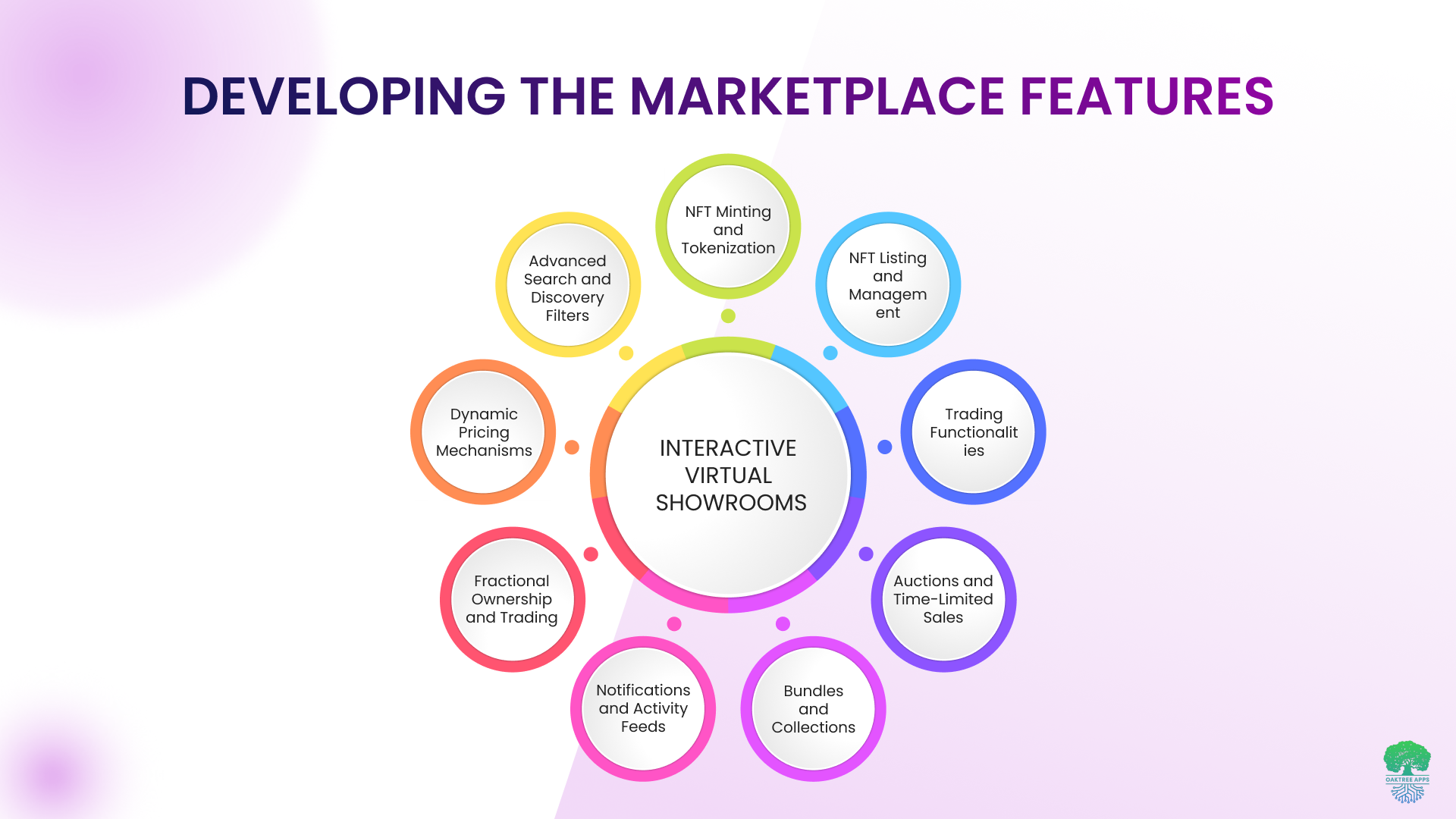May 18 2023

Creating a Feature-Rich Virtual Marketplace
Discover the thriving realm of metaverse NFT marketplaces, where technology and creativity converge to redefine the digital landscape. With increasing user adoption and exponential growth, these virtual ecosystems offer entrepreneurs unprecedented opportunities for innovation and monetization.
Recent research demonstrates the immense potential of this burgeoning industry. According to fortunebusinessinsights, the global metaverse market size was valued at USD 100.27 billion in 2022 and is projected to grow USD 1,527.55 billion by 2029, at a CAGR of 47.6%. As the metaverse expands, entrepreneurs can carve their path by developing specialized NFT marketplaces, targeting niche communities and industries. Whether it's a virtual art gallery, a gaming marketplace, or a platform for virtual real estate, the possibilities are limitless.
Our comprehensive guide on metaverse NFT marketplace development equips you with the knowledge and insights to navigate this transformative landscape. So let's dive in and seize the opportunities and shape the future of digital asset trading in the metaverse.
Understanding the Metaverse and NFTs
The metaverse, a term coined by science fiction author Neal Stephenson, represents a virtual universe that transcends the boundaries of traditional online spaces. It offers a rich, immersive environment where users can interact, create, and transact with digital assets in real-time. In the metaverse, individuals can explore diverse virtual landscapes, engage with other users, and participate in a wide range of activities, such as gaming, socializing, shopping, and even attending virtual events.
Central to the metaverse experience are non-fungible tokens (NFTs). They are unique digital assets that leverage blockchain technology to provide indisputable proof of ownership, authenticity, and scarcity. Unlike cryptocurrencies, such as Bitcoin or Ethereum, NFTs cannot be exchanged on a one-to-one basis since each token possesses distinct properties and characteristics. This uniqueness has opened new avenues for digital creators, artists, and collectors to monetize and showcase their work within the metaverse. Additionally, NFTs have opened up new avenues for virtual real estate ownership, gaming assets, virtual fashion, and even virtual identities, allowing users to express themselves and participate in the metaverse economy in unprecedented ways.

Types of Metaverse NFT Marketplaces
Within the metaverse, various marketplaces cater to distinct aspects of the virtual ecosystem. Here are some different types of metaverse marketplaces:
Metaverse NFT Art Marketplaces:
Metaverse NFT art marketplaces serve as dedicated platforms for artists, collectors, and enthusiasts to create, trade, and own virtual artworks represented as NFTs. They provide a curated environment for artists to showcase their digital art, interact with a global audience, and monetize their creations.
Virtual Gaming Metaverse Marketplaces:
Virtual gaming metaverse marketplaces focus on the exchange of in-game assets, virtual currencies, and gaming-related NFTs. They enable gamers to buy, sell, and trade virtual items, such as weapons, skins, or avatars, allowing for customization and enhancing the gaming experience. These marketplaces often integrate with popular gaming platforms or virtual worlds, providing seamless integration and interoperability of gaming assets across different metaverse experiences.
Virtual Real Estate Marketplaces:
Virtual real estate marketplaces facilitate the trade of virtual land, properties, and spaces within the metaverse. Users can buy, sell, or rent virtual real estate assets represented as NFTs. These marketplaces provide a platform for individuals or businesses to acquire and develop virtual properties, creating virtual communities, business ventures, or immersive experiences.
E-Commerce Metaverse Marketplaces:
Electronic commerce metaverse marketplaces emulate traditional e-commerce platforms within the virtual world. They enable users to buy and sell a wide range of virtual goods, products, or services represented as NFTs. Users can transact for virtual fashion items, accessories, virtual furniture, or even digital services like virtual consultation or design services.
Virtual Experiences Metaverse Marketplaces:
Virtual experiences metaverse marketplaces focus on providing access to virtual events, immersive experiences, and entertainment within the metaverse. Users can purchase tickets or access passes represented as NFTs to attend virtual concerts, exhibitions, conferences, or exclusive virtual experiences hosted within the metaverse.
Virtual Services Metaverse Marketplaces:
Virtual services metaverse marketplaces facilitate the exchange of virtual services within the metaverse ecosystem. Users can offer or avail themselves of services such as virtual consulting, design, programming, or other digital services represented as NFTs. These marketplaces provide freelancers, professionals, or service providers a platform to highlight their skills, connect with clients, and execute service agreements within the virtual world.
How Does an NFT Marketplace Work in the Metaverse?
In the metaverse, an NFT marketplace serves as a digital platform within the virtual environment where users can trade, buy, and sell NFTs. It integrates seamlessly into the metaverse, allowing users to access the marketplace using their avatars or digital identities.
The marketplace enables creators and artists to mint their digital assets as NFTs, assigning unique tokens representing ownership and authenticity on the blockchain. These NFTs can be listed for sale or auctioned within the metaverse marketplace, providing an avenue for users to discover and explore a wide range of digital assets.
Users can browse through distinct categories, search for specific keywords, or explore curated collections to find NFTs of interest. Once users find an NFT they want to purchase, they can initiate the buying process, which typically involves reviewing the price and details, confirming the purchase, and paying using their integrated digital wallets. The ownership of the NFT is then transferred from the seller to the buyer within the metaverse environment, recorded securely on the blockchain.
Additionally, some metaverse NFT marketplaces support auctions, where users can place bids on NFTs and compete to acquire them. Social interactions, virtual showcasing, and community engagement are also integral components of metaverse NFT marketplaces, allowing users to connect, appreciate, and display their NFT collections within the virtual realm.
How Can I Create My Own NFT Marketplace?
If you're looking to create your own metaverse NFT marketplace, following a strategic and well-executed approach is important. Here's a step-by-step guide to help you on your journey:
Define Your Marketplace Concept
Determine the type of NFTs you want to focus on, whether art, virtual real estate, gaming assets, or other digital collectibles. Understanding your niche will help shape your marketplace's features and functionalities.
Identifying Your Target Audience
Conduct thorough market research to identify your potential users' demographics, interests, and motivations. Tailor your marketplace to cater to their specific desires, whether it's art collectors seeking unique digital pieces, gamers looking for rare in-game assets, or enthusiasts interested in virtual real estate.
Innovative Revenue Models
Consider revenue models that generate sustainable income and align with your marketplace's value proposition. Explore options such as transaction fees, listing fees, subscription models, or innovative approaches like decentralized autonomous organizations (DAOs) where users participate in governance and profit-sharing. Evaluate the pros and cons of each model in relation to your target audience and long-term growth strategy.
Ready to Dive into the Metaverse NFT Marketplace?
Connect with our professionals today
Talk to Our ExpertsDesigning the User Interface and Experience for NFT Metaverse Development
Designing an intuitive and visually appealing user interface (UI) and creating a seamless user experience (UX) is crucial for a thriving NFT metaverse marketplace. Here are some specific tips tailored to the unique aspects of NFT metaverse development:
Showcase NFTs with Immersive Previews: Implement interactive and immersive previews for NFTs, allowing users to experience the artwork or virtual asset in detail. For 2D art, enable users to zoom in and explore intricate details. For 3D assets, provide a 360-degree view or virtual reality (VR) integration to allow users to inspect the asset from all angles.
Categorize NFTs for Easy Exploration
Organize NFTs into meaningful categories and collections to facilitate seamless browsing.
Consider categories based on art styles, virtual worlds, gaming genres, or unique attributes.
Implement intuitive filtering options to help users refine their search based on attributes like rarity, artist, price range, or specific virtual environments.
Gamify the NFT Marketplace Experience
Infuse gamification elements into your NFT metaverse marketplace to enhance user engagement. Incorporate features such as badges, achievements, leaderboards, and challenges tied to NFT ownership, trading volumes, or community participation.
Customizable User Profiles
Provide users with customizable profiles to showcase their NFT collections, preferences, and achievements. Allow users to personalize their profiles with avatars, backgrounds, or bios. Enable users to curate and display their favorite NFTs or virtual assets on their profile page, creating a unique identity within the metaverse.
Collaborative NFT Exploration
Implement features that allow users to create and share curated collections or virtual exhibitions. Enable users to collaborate on shared virtual spaces to highlight their NFTs collectively.

Developing the Marketplace Features
User Authentication and Wallet Integration
Enable users to create accounts and authenticate their identities within the marketplace. Integrate popular cryptocurrency wallets, such as MetaMask or Trust Wallet, to allow users to connect their wallets seamlessly.
NFT Minting and Tokenization
Provide users with the ability to mint and tokenize their digital assets as NFTs directly within the marketplace. Implement a user-friendly interface that guides users through the minting process, including metadata input, media upload, and token issuance.
NFT Listing and Management
Provide a user-friendly dashboard where sellers can easily create, edit, and manage their listings. Enable options for setting prices, royalties, and auction durations, giving sellers flexibility and control over their NFTs' availability and pricing.
Trading Functionalities:
Implement seamless buying, selling, and bidding functionalities to enable users to trade NFTs. Facilitate smooth transactions with features like instant purchases, bidding systems, and offer management. Ensure transparency and security by integrating with blockchain technology and smart contracts.
Auctions and Time-Limited Sales
Enhance the marketplace experience by incorporating auction features. Allow users to participate in bidding for limited-edition or exclusive NFTs. Implement countdown timers, bid notifications, and bid history to create a sense of excitement and urgency.
Bundles and Collections
Enable users to create and sell bundles or collections of NFTs. Users can package related NFTs together, providing value and convenience to buyers. Implement features that allow users to discover and purchase curated collections, enhancing cross-promotion opportunities for artists and creators.
Notifications and Activity Feeds
Keep users informed about marketplace activities and updates through notifications and activity feeds. Notify users about successful transactions, bid updates, new listings from followed artists, or upcoming events. Provide a personalized feed that displays relevant updates based on user preferences and activity.
Fractional Ownership and Trading
Enabling fractional ownership of NFTs creates new opportunities for users to invest in high-value assets. Fractional ownership allows multiple individuals to collectively own a share of an NFT, making it more accessible to a wider audience. Additionally, supporting secondary trading of fractionalized NFT shares enhances liquidity and investment possibilities.
Dynamic Pricing Mechanisms
Implementing dynamic pricing mechanisms, such as auction-style bidding, allows NFTs to be sold to the highest bidder, creating a sense of excitement, and driving up the value of highly sought-after assets. Additionally, incorporating pricing algorithms that adjust based on market demand and scarcity can optimize the pricing of NFTs.
Advanced Search and Discovery Filters
Provide advanced search and discovery options based on various criteria, such as artist, genre, rarity, and attributes, to let users navigate the marketplace more effectively.
Interactive Virtual Showrooms
Integrating interactive virtual showrooms or galleries within the marketplace allows users to visually display their NFT collections. Virtual reality (VR) or augmented reality (AR) technologies can be leveraged to create immersive experiences where users can explore and interact with NFTs in a virtual environment.
Technological Attributes Present in Metaverse Marketplace Development
Virtual Reality (VR) and Augmented Reality (AR)
Integrating VR and AR technologies within the marketplace allows users to experience NFTs in immersive and interactive ways. VR can create virtual galleries or exhibitions where users can navigate and explore the artwork in a realistic environment, while AR can overlay digital assets onto the physical world, enhancing their visualization and contextualization.
Interoperability and Cross-Chain Communication
Interoperability protocols and cross-chain communication standards allow seamless interaction and asset transfers between different blockchain networks. Protocols like Polkadot or Cosmos facilitate cross-chain compatibility, enabling users to trade NFTs across various blockchain ecosystems. This enhances liquidity and expands the reach of NFTs within the metaverse.
Secure Multi-Party Computation
Utilizing secure multi-party computation (MPC) protocols ensures the privacy and security of user data. MPC allows for collaborative computations without exposing individual data inputs, preserving confidentiality in sensitive operations such as auctions or identity verification. This protects user privacy while maintaining the necessary trust and security within the marketplace.
Distributed Storage Systems
Implementing distributed storage systems, such as IPFS (InterPlanetary File System), ensures reliable and decentralized storage of NFT metadata and content. This approach prevents a single point of failure, enhances data availability, and reduces reliance on centralized servers. Users can access NFT information efficiently, even during network disruptions or server failures.
Integrating Blockchain and Smart Contracts
Selecting the Appropriate Blockchain Platform
Evaluate different blockchain platforms based on factors like scalability, transaction costs, community support, and NFT standard compatibility. Ethereum is a popular choice for NFTs, but also consider other platforms like Binance Smart Chain, Flow, or Polygon, depending on your specific needs.
Developing Smart Contracts
Design and develop smart contracts that govern the creation, ownership, and trading of NFTs. Use programming languages like Solidity or Vyper to write the smart contract code. Define functions for minting, transferring ownership, managing royalties, and enforcing marketplace rules. Thoroughly test the smart contracts to ensure they are secure and function as intended.
Deploying Smart Contracts
Deploy the developed smart contracts onto the chosen blockchain platform. Use tools like Truffle, Hardhat, or Remix to compile and deploy the contracts to the blockchain network of your choice. Follow best practices for contract deployment, including verifying the source code and contract metadata.
Interacting with Smart Contracts
Integrate smart contracts into your marketplace's backend system. Develop APIs or web services that allow seamless communication between the frontend user interface and the smart contracts on the blockchain. This enables users to interact with smart contracts to perform actions such as buying, selling, bidding, or transferring NFT ownership. Implement robust error handling and validation to ensure accurate and secure interactions.
Wallet Integration
Integrate cryptocurrency wallets into your marketplace to facilitate secure transactions and interaction with smart contracts. Utilize wallet APIs or SDKs provided by popular wallet providers to enable users to connect their wallets and sign transactions directly from your marketplace. This integration ensures the secure handling of private keys and provides a seamless user experience.
Implementing Blockchain Data Retrieval
Retrieve and display blockchain data related to NFTs and transactions within your marketplace. Utilize blockchain explorers or custom APIs to fetch data such as transaction history, ownership records, and NFT metadata. This data can be used to verify ownership, display NFT details, and provide transparency to users.
Security and Auditing
Implement stringent security measures to protect user data, prevent unauthorized access, and secure smart contract interactions. Conduct thorough security audits of both the marketplace infrastructure and the smart contracts. Follow security best practices, including code reviews, penetration testing, and continuous monitoring, to proactively identify and address potential vulnerabilities.
Testing and Quality Assurance
Thorough testing and quality assurance are essential for a dependable and seamless metaverse NFT marketplace. By identifying and resolving issues before launch, you can ensure stability, functionality, and security.
Perform comprehensive unit testing on individual components like smart contracts, APIs, and backend functionalities. Validate interactions between different components through integration testing. Test communication between frontend, backend, and blockchain integration layers. Conduct rigorous security testing to address vulnerabilities and penetration testing to assess system robustness.
Implement a monitoring system to track marketplace performance and availability in real-time. Monitor key metrics, error logs, and user feedback to identify and address issues promptly. Utilize error tracking tools for exception analysis, enabling quick bug fixes and continuous improvement.
Launching and Marketing Your Marketplace
Launching your metaverse NFT marketplace requires careful planning and effective marketing strategies to attract users and build a vibrant community. Start by releasing beta versions to gather user feedback and generate buzz. Collaborate with influencers, create educational content, leverage social media, and explore partnerships with virtual worlds to expand your reach. Engage your audience, foster community, and position your marketplace for success in the thriving metaverse ecosystem.
Unlock the Potential of Your Metaverse NFT Marketplace!
Connect with our experts today to launch and market your platform
Talk to Our Experts Now!Cost Estimation of Metaverse NFT Marketplace Software Development
Developing a full-fledged custom Metaverse NFT marketplace will cost in the range of $100K to $500K. The cost estimation of developing a metaverse NFT marketplace depends on several factors such as the complexity of features, design requirements, blockchain integration, and security considerations. The intricacy of the marketplace's functionalities, user experience design, and integration with blockchain technology can influence the overall development cost. Additionally, implementing robust security measures and conducting audits contribute to the budget. It is essential to carefully consider these factors to arrive at an accurate cost estimation for metaverse NFT marketplace software development.
Oaktree Apps' expertise in blockchain technology, smart contracts, user experience design, and security ensures that your marketplace will be innovative, secure, and tailored to meet the needs of your target audience. with Oaktree Apps by your side and witness the transformation of your vision into a thriving reality within the metaverse ecosystem.

